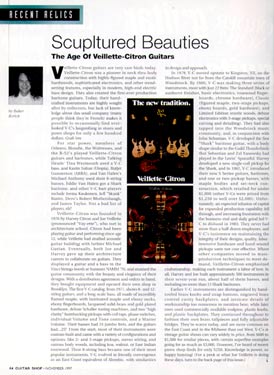
| ||
Articles
For star power, members of Orleans, Blondie, the Waitresses, and the B-52's played Veillette-Citron guitars and baritones, while Talking Heads' Tina Weymouth used a V-C bass, and Kasim Sultan (Utopia), Rutjer Gunnerson (ABBA), and Van Halen's Michael Anthony used their 8-string basses. Eddie Van Halen got a Shark baritone, and other V-C ban players include Jorma Kaukonen, Jeff "Skunk" Baxter, Devo's Robert Mothersbaugh, and James Taylor. Not a bad list of players, eh? Veillette-Citron was founded in 1976 by Harvey Citron and Joe Veillette (pronounced "Vay-ette"), who met in architecture school. Citron had been playing guitar and performing since age 12, while Veillette had studied acoustic guitar building with luthier Michael Gurian. Eventually, both Joe and Harvey gave up their architecture careers to collaborate on guitars. They displayed a guitar and a bass in the Vinci Strings booth at Summer NAMM `76, and stunned the guitar community with the beauty and elegance of their designs. With a distribution agreement and orders in hand, they bought equipment and opened their own shop in Brooklyn. The first V-C catalog, from 1977, shows 6- and 12-string guitars, and a long-scale bass, all made of incredibly flamed maple, with laminated maple and ebony necks, ebony fingerboards, lacquered solid-brass and gold-plated hardware, deluxe Schaller tuning machines, and two "high clarity" humbucking pickups with coil taps, phase switches, individual Volume and Tone controls, and a Master Volume. Their basses had 24 jumbo frets, and the guitars had... 25! From the start, most of their instruments were custom-built and came with a variety of configurations and options, like 2- and 3-stage pickups, stereo wiring, and various body woods, including koa, walnut, or East Indian rosewood. Their 8-string bass became one of their most popular instruments. V-C evolved in friendly convergence as an East Coast equivalent of Alembic, with similarities in design and approach.
In 1979, v-c moved upstate to Kingston, NY, on the Hudson River not far from the Catskill mountain town of Woodstock. By 1980, V-C was making three series of instruments, most with just 22 frets: The Standard (black or sunburst finishes, basic electronics, rosewood finger-boards, chrome hardware), Classic (figured maple, two-stage pickups, ebony boards, gold hardware), and Limited Edition (exotic woods, deluxe electronics with 3-stage pickups, special carving and detailing). They had also tapped into the Woodstock music community, and, in conjunction with John Sebastian, V-C developed the first "Shark" baritone guitar, with a body shape similar to the Guild Thunderbirds that Sebastian and Zal Yanowsky had played in the Lovin' Spoonful. Harvey developed a new single-coil pickup for the Shark, and in 1982, V-C introduced their new S Series guitars, baritones, and one or two-pickup basses, with maple bodies and set-neck con struction, which retailed for under $1,000 (other V-Cs were priced from $1,250 to well over $2,000). Unfortunately, an expected infusion of capital for expanded production capability fell through, and increasing frustration with the business-end and daily grind led V-C to disband in 1983. They never had more than a half-dozen employees, and V-C's insistence on maintaining the integrity of their designs, quality, labor-intensive hardware and hand-wound pickups were not cost effective. Where other companies moved to mass-production techniques to meet demand, Veillette-Citron emphasized craftsmanship, making each instrument a labor of love. In all, Harvey and Joe built approximately 500 instruments in their seven-year run, about half of them basses, and including no more than 15 Shark baritones. Earlier V-C instruments are distinguished by hand- tooled brass knobs and strap buttons, engraved brass control cavity backplates, and intricate details of workmanship too numerous to mention here, while later ones used commercially available endpins, plastic knobs, and plastic backplates. They continued throughout to fashion their own brass tailpieces and fully adjustable bridges. They're scarce today, and are more common on the East Coast and in the Midwest than out West. V-C's at vintage guitar shows can vary widely in price, from $600 to $1,500 for similar pieces, with certain superfine examples going for as much as $3,000. However, I've heard of recent pawn shop finds for only $250. Knowledge is power, so happy hunting! (For a peek at what Joe Veillette is doing these days, turn to the back page of this issue.)
| ||
| © Veillette Guitars SEARCH OUR SITE |
 Sculptured Beauties
Sculptured Beauties